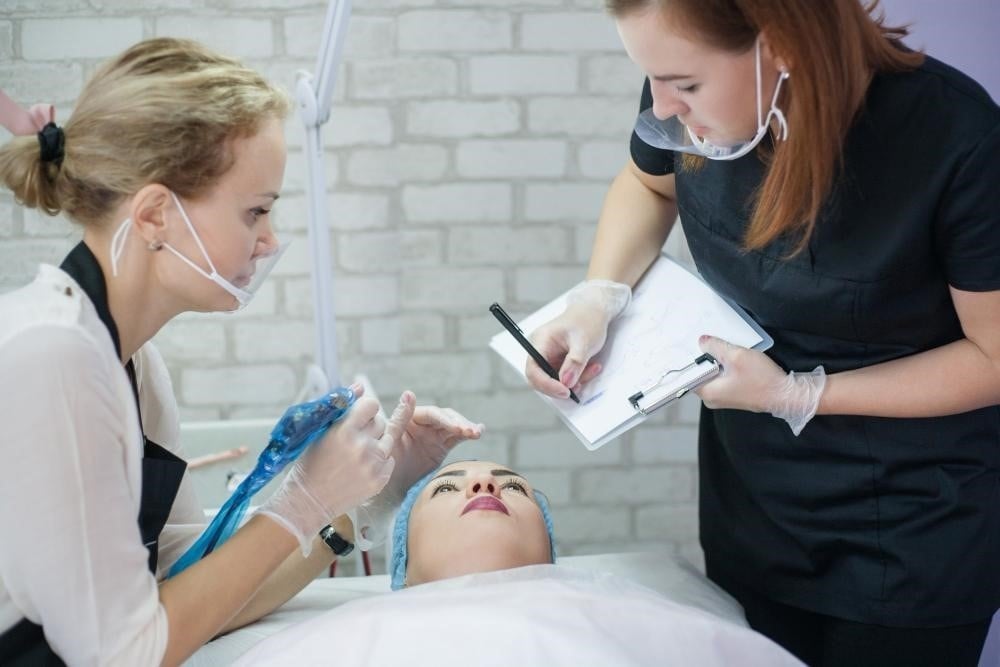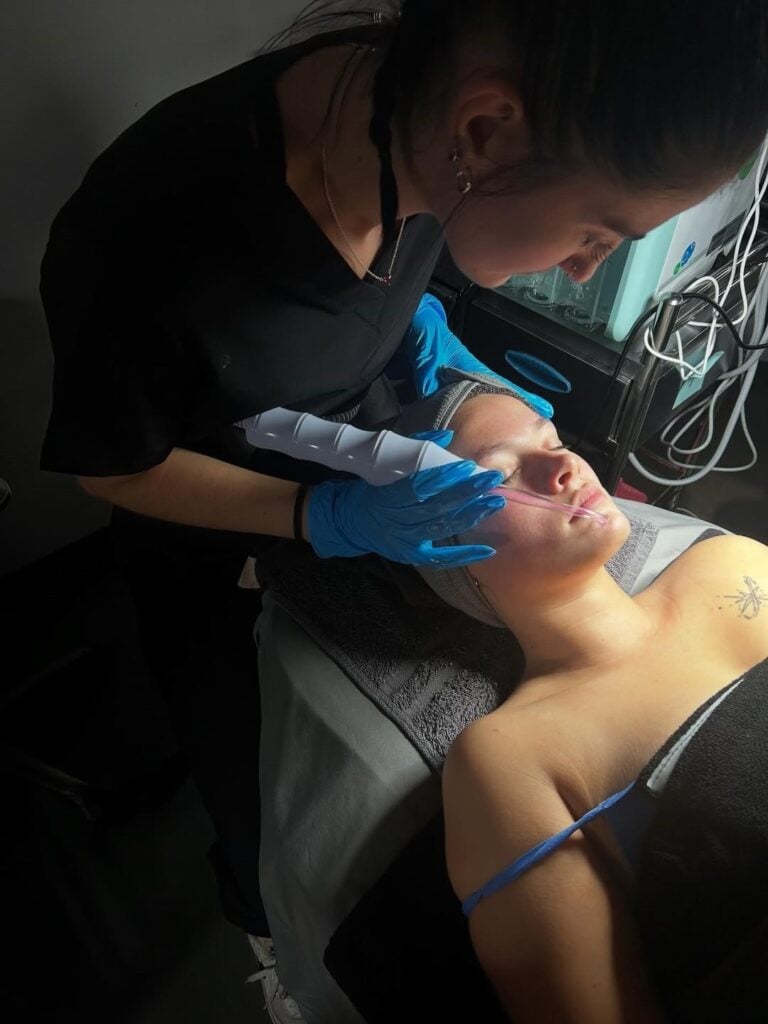Medical esthetics sits right at the intersection of beauty and science. And as medical spas and dermatology practices keep expanding across the country, the demand for people who actually understand both sides of this work just keeps growing. At Cosmetology & Spa Academy, we’ve built our esthetics program around one core idea: preparing you for real clinical work, not just theory. W hether you’re exploring this career for the first time or you’re ready to take the next step, here’s what you need to know about how to become a medical esthetician.

What Is a Medical Esthetician?
A medical esthetician (sometimes called a paramedical esthetician) is a licensed skincare professional who works in clinical settings. Think dermatology offices, plastic surgery practices, medical spas—places where skincare meets healthcare.
The difference between a traditional esthetician and a medical one? Traditional estheticians focus on beauty treatments and relaxation. Medical estheticians do that too, but they’re also working alongside doctors, assisting with procedures, and helping patients through recovery after surgery or medical treatments.
So, what does a medical esthetician do? You might perform microdermabrasion, chemical peels, or LED light therapy. You could be prepping a patient’s skin before a procedure or caring for it afterward.
And honestly, some of the most meaningful work happens when you’re teaching someone how to manage sensitive skin, reduce scarring, or use makeup techniques to feel like themselves again after a major health event.
It’s clinical work with heart. That’s what drew a lot of our graduates to this field.
What Does a Medical Esthetician Actually Do?
The role changes depending on where you work. In a dermatology office, you might spend your day consulting with patients, preparing treatment areas, performing advanced facials, and walking people through their aftercare routines. In a medspa, you could be doing laser treatments, deep exfoliation, or lymphatic drainage—all under a physician’s supervision.
Here’s what a typical day might include:
Patient consultations – Understanding their skin concerns, medical history, and what they’re hoping to achieve
Advanced treatments – Chemical peels, microdermabrasion, resurfacing procedures, post-surgical care
Client education – Teaching proper skincare routines, explaining what to expect during healing, recommending products
Safety protocols – Medical-grade sanitation, infection control, documentation
One thing we always tell students: this isn’t just about making people look good. You’re often working with patients who’ve been through surgery, dealt with severe acne, or are recovering from cancer treatment. The emotional side of this work matters just as much as the technical side.
According to the U.S. Bureau of Labor Statistics, employment for skincare specialists is projected to grow 11% through 2032—way faster than most careers. The demand for estheticians who understand both beauty and clinical care? It’s only going up.

How to Become a Medical Esthetician
Becoming a medical esthetician isn’t complicated, but it does require the right education and hands-on experience. Let’s take a look at the medical esthetician requirements in Illinois and how the process really works:
1. Complete an Esthetics Program
You’ll need to enroll in a state-approved esthetics program like ours here at CSA. Illinois requires 750 training hours for licensure, and we cover everything—skincare fundamentals, anatomy, infection control, advanced facial techniques, and more.
We run our programs across four campuses (Crystal Lake, Elgin, Rockford, and Schaumburg), and we’ve designed our schedules to work whether you’re a full-time student or balancing other commitments.
2. Get Licensed
Once you complete your training, you’ll take the Illinois State Board exam. It’s got both a written and a practical component. Pass that, and you’re licensed to work in spas, salons, and medical settings.
3. Pursue Specialized Training
Here’s where it gets interesting. There’s no separate “medical esthetician license”—it all starts with your standard esthetician license. But to really work in clinical environments, you’ll want additional medical esthetician certifications and training in things like:
- Chemical peels
- Microdermabrasion
- LED light therapy
- Pre- and post-surgical skincare
- Laser-assisted treatments
A lot of our graduates continue their education after licensing. It’s how you stand out when you’re applying to medical practices and medspas.
4. Build Clinical Experience
The real learning happens when you start working under dermatologists or plastic surgeons. That’s where you refine your skills, learn how to work with patients in vulnerable moments, and figure out what areas of medical esthetics you’re most drawn to.

What You’ll Learn in Our Program
We don’t just teach you how to perform treatments—we teach you how to think about skin health, assess client needs, and understand how the skin responds to medical interventions.
Our curriculum covers:
- Anatomy and physiology (you need to know how skin actually works)
- Skin disorders and contraindications
- Infection control and sanitation standards
- Chemical exfoliation and resurfacing techniques
- Lymphatic drainage and facial massage
- Pre- and post-operative skincare protocols
- Advanced modalities like LED therapy and microdermabrasion
What makes our program different? Our facilities at CSA are designed to fully accommodate students who are looking for a medical esthetician school. We replicate actual professional environments.
You’re not just learning in a classroom. You’re practicing in treatment rooms that look and feel like the real thing. Our instructors come from salons, spas, and clinical backgrounds, so they know what you’ll actually encounter when you graduate.
And from day one, you’re working with clients. We believe in hands-on training because there’s no substitute for real experience.
Certification and Licensing Requirements
Let’s clear something up: there’s no separate medical esthetician license in Illinois. What you need is:
- Graduation from a state-approved medical esthetician program (like ours)
- Passing the Illinois State Board exam
- Any additional training your employer requires
Many medical estheticians pursue voluntary certifications through continuing education—microblading, advanced chemical peels, specialized facial protocols. It strengthens your resume and gives you more treatment options to offer clients. We’ve seen it make a real difference when our graduates are interviewing for positions.
Where Medical Estheticians Work
Once you’re licensed, you’ve got options. A lot of our graduates work in:
- Dermatology clinics
- Plastic surgery offices
- Medical spas (medspas)
- Laser treatment centers
- Wellness and rehabilitation facilities
Some eventually open their own studios. Others partner with physicians through management service organizations (MSOs) to operate medspas—there are legal requirements around that structure in Illinois, but it’s definitely a path worth exploring if you’re entrepreneurial.
We also offer career placement support here at CSA. We help with resumes, portfolios, interview prep—all the stuff that actually matters when you’re trying to land your first position.
Salary and Job Outlook
Let’s talk money. According to Glassdoor, medical estheticians typically earn between $70K and $116K a year. That range depends on a few things:
- Where you’re working (both the type of facility and the location)
- Your certifications and specialized training
- How much experience you have
If you’re in a high-demand metro area or you’ve invested in advanced certifications, you can earn significantly more. Fortunately, medical esthetician employment is truly booming everywhere. We’ve had graduates land positions quickly and start specializing within their first year or two—it makes a difference.

Is This Career Right for You?
If you care about helping people feel better about themselves, if you’re detail-oriented, and if you’re genuinely interested in the science behind skincare—this might be your field.
Fair warning: it’s not always easy. You’ll work with patients who are self-conscious about their skin, who’ve been through trauma, or who are healing from surgery. The emotional weight of that can be a lot. But that’s also what makes it meaningful.
One of our instructors tells students on their first day: “You’re going to help someone look in the mirror and feel like themselves again. That’s not a small thing.”
Keep Learning
Medical esthetics evolves constantly. New technologies, new ingredients, new treatment methods—if you stop learning, you fall behind. Continuing education isn’t just about keeping your license active (though it does that). It’s about staying competitive and offering your clients the best possible care.
Ready to Start?
If this sounds like the kind of work you want to do, it starts with the right training. We offer state-accredited esthetics programs.
Here’s what we provide:
- Programs that meet all Illinois licensing requirements
- Real-world practice in professional treatment rooms
- Career support and medical esthetician jobs placement assistance
- Flexible scheduling (full-time and part-time options)
- Instructors who’ve actually worked in the field
Want to learn more? Book a tour to see our campuses call us at 815-455-5900 or email info@csa.edu. We can walk you through start dates, financial aid options, and anything else you’re wondering about.
Frequently Asked Questions
What’s the actual difference between an esthetician and a medical esthetician?
Medical estheticians work in clinical settings and perform more advanced treatments, often assisting doctors. Both need a state esthetics license, but medical estheticians usually have extra specialized training.
Do I need a special license to work in medical settings?
No—you need your standard state esthetician license. Medical settings typically require additional certifications and supervised experience, but there’s no separate “medical esthetician license.”
How long does the training take in Illinois?
Usually 6–12 months, depending on whether you’re going full-time or part-time and how quickly you complete your 750 required hours.
Where do most medical estheticians end up working?
Dermatology offices, plastic surgery clinics, medspas, and rehabilitation centers. Basically anywhere that combines healthcare with skincare.
What’s the medical esthetician pay like?
Most medical estheticians make between $70,000 and $160,000 a year. It varies based on experience, location, certifications, and the type of facility you work in.
